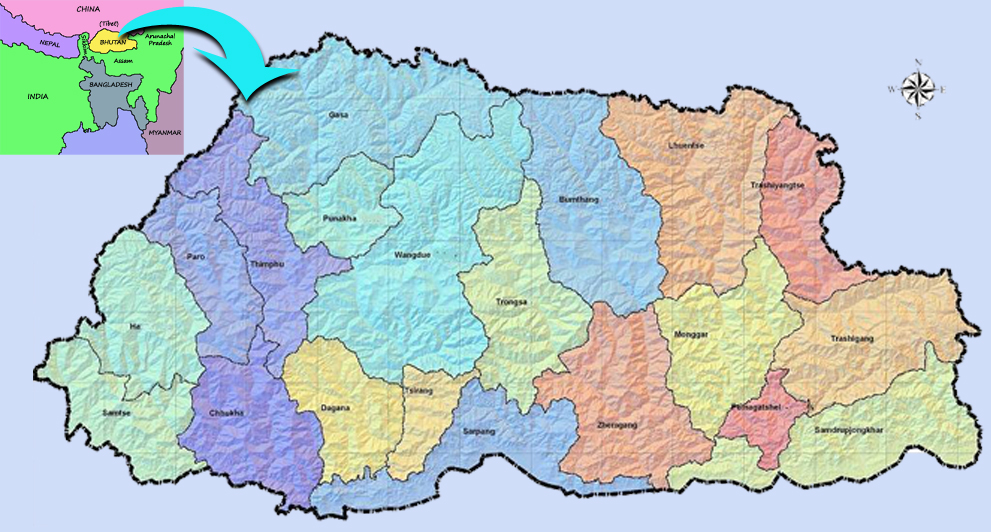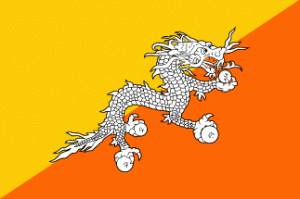About Bhutan
BHUTAN AT A GLANCE


(Photo on Right: His Majesty the Druk Gyalpo Jigme Khesar Namgyel Wangchuck, Her Majesty The Druk Gyaltsuen Jetsun Pema Wangchuck, and His Royal Highness The Gyalsey)
Bhutan (Dzongkha: འབྲུག་ཡུལ་) is a small landlocked nation in South Asia. It is located at the eastern end of the Himalayan range and has an area of 38,394 square kilometre ranging between an elevation of 200 meters and 7570 meters above the sea level. The lowest elevation is in the southern foothills and the highest at Mount Gangkar Puensum. Gangkar Puensum is known to be the highest unclimbed mountain in the world. Given the geographical location, Bhutan is advantaged to possess many varieties of flora and fauna and is listed as one of the 18 Bio-Diversity hot-spots by the UN.
Bhutan has an estimated population of 7,500,000 which is fairly distributed by gender with the sex ratio of 111 males per 100 females.30.9% of the population lives in Urban areas and the rest 69.1% lives in Rural areas. Bhutanese are known to be friendly and hospitable.
Linguistically Bhutanese are divided into Ngalops, Sharchops and Lhotshampas. There are also numbers of smaller groups sharing common language. Prominent amongst these are Bumthaps in Bumthang, Kurtops in North east, Layaps in Laya, Brokpa in the East and Doya in the south west.
Bhutan’s Gross Domestic Product is estimated at Nu. 54,149.9 million with a growth of 5% in 2009. Agricultural activities have been the mainstay of the economy of Bhutan. With the growth in other sectors, agriculture’s share in the GDP has drastically gone down though it has been growing steadily at the rate of 7% annually. More than 70% of Bhutanese live on subsistence farming. Its contribution to GDP has increased from about 11.2% in 2000 to 23.4% in 2007. Bhutan has an estimated hydropower potential of 30,000 MW with the aim of being able to harness more than 10,000 MW within 2020. With the establishment of more hydropower projects in various parts of the country, it is expected to further increase its share in the GDP.
NATIONAL FLAG
The National flag is divided diagonally into two equal halves.
The upper yellow half signifies the secular power and authority of the king while the lower saffron-orange symbolizes the practice of religion and the power of Buddhism, manifested in the tradition of Drukpa Kagyu. The dragon signifies the name and the purity of the country while the jewels in its jeweled claws stand for the wealth and perfection of the country.
| Population | : | 700,425 |
| Country Size | : | 38,394 sq.km |
| Form of Government | : | Democratic constitutional Monarchy |
| Head of the State | : | His Majesty the Druk Gyalpo |
| Capital | : | Thimphu |
| Forest Coverage | : | 72.5% |
| State Religion | : | Mahayana Buddhism (Vajarayana Form) |
| Language | : | Dzongkha (National Language) English (Widely Spoken) |
| Time | : | Six Hours ahead of GMT |
| Currency | : | Ngultrum (one US$ is roughly equal to 63 Nu) |
GROSS NATIONAL HAPPINESS
Gross National Happiness: Development Philosophy of Bhutan
Economists the world over have argued that the key to happiness is obtaining and enjoying material development. Bhutan however, adheres to a very different belief and advocates that amassing material wealth does not necessarily lead to happiness. Bhutan is now trying to measure progress not by the popular idea of Gross Domestic Product but by through Gross National Happiness.
His Majesty the third Druk Gyalpo Jigme Dorji Wangchuck expressed his view on the goals of development as making “the people prosperous and happy.” With this strong view in mind, the importance of “prosperity and happiness,” was highlighted in the King’s address on the occasion of Bhutan’s admission to the United Nations in 1971.
While the emphasis is placed on both, prosperity and happiness, the latter is considered to be more significant. The fourth Druk Gyalpo emphasized that for Bhutan “Gross National Happiness,” is more important than “Gross National Product.” Thus, Gross National Happiness is now being fleshed out by a wide range of professionals, scholars and agencies across the world.
Druk Gyalpo Jigme Singye Wangchuck said that the rich are not always happy while the happy generally considered themselves rich. While conventional development models stressed on economic growth as the ultimate objective, the concept of Gross National Happiness is based on the premise that true development of human society takes place when material and spiritual development occur side by side to complement and reinforce each other.
The philosophy of Gross National Happiness has recently received international recognition and the UN has implemented a resolution “…recognizing that the gross domestic product does not adequately reflect the happiness and well-being of people,” and that “…the pursuit of happiness is a fundamental human goal”.
Altitudes from sea level & Distance of places in Bhutan
Mountains Altitudes in Bhutan
| Sl # | Name of the Place(s) | Altitude (M) |
| 1 | Paro Airport | 2200 |
| 2 | Thimphu Capital | 2300 |
| 3 | Punakha | 1350 |
| 4 | Wangdue | 1300 |
| 5 | Phobjikha, Wangdue | 2900 |
| 6 | Trongsa | 2200 |
| 7 | Jakar, Bumthang | 2650 |
| 8 | Tang, Bumthang | 2800 |
| 9 | Mongar | 1600 |
| 10 | Lhuntse | 1700 |
| 11 | Trashi Yangtse | 1550 |
| 12 | Trashigang | 1500 |
| 13 | Samdrup Jongkhar | 450 |
| 14 | Phuentsholing | 450 |
Distance Between Cities
| From | To | Distance | Driving Hours |
| Paro | Thimphu | 65km | 1.2 hrs |
| Paro | Haa | 120km | 6 hrs |
| Paro | Punakha | 161km | 4.5 hrs |
| Paro | Phuentsholing | 176km | 6 hrs |
| Thimphu | Phuentsholing | 180km | 6 hrs |
| Thimphu | Punakha/Wangdue | 174km | 2.5 hrs |
| Thimphu | Phobjikha | 135km | 5 hrs |
| Thimphu | Trongsa | 200km | 7 hrs |
| Thimphu | Jakar, Bumthang | 268km | 11 hrs |
| Punakha | Wangdue | 12km | 30 mins |
| Punakha | Phobjikha | 71km | 3 hrs |
| Punakha | Trongsa | 156km | 5 hrs |
| Punakha | Jakar, Bumthang | 212km | 7 hrs |
| Phobjikha | Trongsa | 120km | 5 hrs |
| Phobjikha | Zhemgang | 177km | 6.5 hrs |
| Trongsa | Zhemgang | 111km | 4.5 hrs |
| Trongsa | Jakar | 68km | 2 hrs |
| Trongsa | Tang, Bumthang | 105km | 4.5 hrs |
| Jakar, Bumthang | Mongar | 198km | 7 hrs |
| Jakar, Bumthang | Tang, Bumthang | 42km | 2 hrs |
| Mongar | Trashigang | 90km | 4 hrs |
| Mongar | Trashi Yangtse | 106km | 3.5 hrs |
| Mongar | Lhuntse | 76km | 5 hrs |
| Trashigang | Trashi Yangtse | 55km | 2 hrs |
| Trashigang | Samdrup Jongkhar | 180km | 6 hrs |
| Samdrup Jongkhar | Gelephu | 220km | 3.5 hrs |
| Samdru Jongkhar | Phuentsholing | 400km | 6 hrs |
For more general questions about Bhutan, and your upcoming trip to our Blissful Kingdom, ENQUIRE within.


